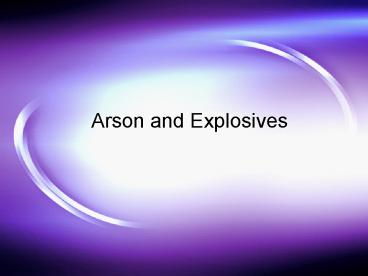Arson and Explosives - PowerPoint PPT Presentation
1 / 17
Title:
Arson and Explosives
Description:
Any flammable liquid or substance used to start and/or maintain a fire is known ... Dynamite. TNT (trinitrotoluene) PETN (pentaerythritol tetranitrate) ... – PowerPoint PPT presentation
Number of Views:239
Avg rating:3.0/5.0
Title: Arson and Explosives
1
Arson and Explosives
2
Forensic Arson and Explosive Investigations
- Two Main Areas of Interest
- isolation and analysis of flammable residues
- collection and analysis of explosive material
- Any flammable liquid or substance used to start
and/or maintain a fire is known as an accelerant - Not all flammable or explosive material will burn
in a fire accelerants always get trapped in
pores in material and will not burn
3
Motives for Arson
- Revenge
- Vandalism (Boredom)
- Profit (Insurance Fraud)
- Concealment of a previous crime
- Terrorism
- Pyromania
4
The Chemistry of Fire
Fire is the product of combustion - the rapid
combination of oxygen with another substance
accompanied by the production of light and heat.
- The energy released comes from the breaking and
reforming of the bonds that hold the compounds
together
5
Ignition temperature
- Two Important Points
- Most combustion reactions will not happen by
themselves (they are not spontaneous).they need
help getting started - Ignition temperature the minimum temperature at
which a fuel will spontaneously ignite.
6
Stages of a fire
- Ignition
- Growth
- Limited to fuel items originally ignited
- Fuel controlled limited by fuel not oxygen
- Flashover
- Hot gases near ceiling reach 600ºC
- All items in room begin to burn
- Post-flashover steady-state burning
- Venillation controlled limited by oxygen
- Decay
7
Determining Point of Origin
- Lowest point that shows most intense burning
- Most intense burning can be determined from
measuring char depth - V-shaped pattern of burn will point to point of
origin - Light bulb burst in direction of highest
temperature - Point to origin
8
Indications of arson
- Lack of evidence of natural or accidental cause
- Evidence that a flammable liquid was among the
first fuels to be ignited - More severe burning on floor than ceiling implies
accelerant - Presence of accelerants
- Portable hydrocarbon detector - detects volatile
organic residues - Multiple points of origin
9
Accelerants and Explosives
- Accelerants and explosives are almost always
organic in nature (wood, gasoline, kerosene,
paper, etc) - If an organic molecule burns completely, the
products are always carbon dioxide and water.
Smoke, ash, carbon monoxide result from
incomplete combustion. - Some materials must reach a temperature at which
they decompose in order to burn (e.g. wood) - Explosive materials are often compounds that are
chemically unstable they want to react and form
more stable molecules
10
Investigating Arson
- Steps to Follow
- Begin collecting evidence as soon as possible.
- Collect totally burned, partially burned, and
unburned samples from the scene for comparison - Back in the forensic lab, isolate and concentrate
the accelerant material - Headspace analysis
- Analyze the material to determine its composition
- GC or GC/MS
11
Gas Chromatograms
12
Explosives
- Explosives are substance that undergo a rapid
exothermic oxidation reaction, with the
production of a large quantities of gases. - Often oxidizing agents
- Inorganic nitrate, chlorates and perchlorates
- High explosives
- Dont need to be confined to explode
- Detonation velocity gt 1000m/s
- TNT
- Low explosive
- Deflagration velocity lt 1000m/s
- Need to be confined or contained to explode
13
Low explosives
- Black powder
- Consists of charcoal and sulfur fuel and nitrate
oxidant - Smokeless powder
- Gun powder
- Singe-base contains only nitrocellulose
- Double-base contains nitroglycerine and
nitrocellulose
14
High explosives
- Primary
- Sensitive to heat, shock, or friction
- Used to detonate main explosion
- Lead azide (PbN3)
- Secondary
- Relatively stable
- Will burn if small quantities ignited in open
- Dynamite
- TNT (trinitrotoluene)
- PETN (pentaerythritol tetranitrate)
- RDX (cyclotrimethylenetrinitramine)
- Tetryl (2,4,6-trinitrophenylmethylnitramine)
15
Home-made Explosives
- ANFO
- Ammonium nitrate soaked in fuel oil
- Believed to be used in
- World Trade bombing (pre 9/11)
- Oklahoma City bombing
16
Collecting Evidence
- Collect bomb pieces which are widely scattered
- Determine origin of blast
- A crater surrounded by debris
- Soil around origin is removed and stored in
air-tight container - Later washed with organic solvents to extract
residues for analysis
17
Analysis of Explosives
- IMS - ion mobility spectrometry
- SEM-scanning electron microscope
- Color tests
- IR
- AA
- GC/MS































